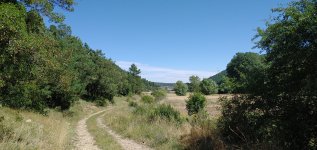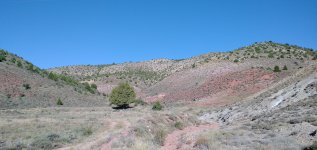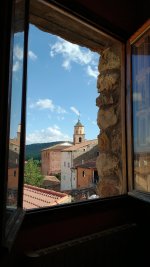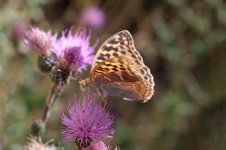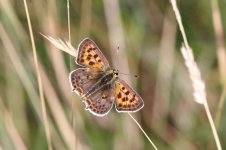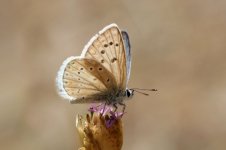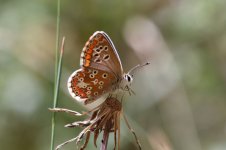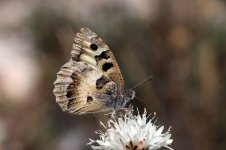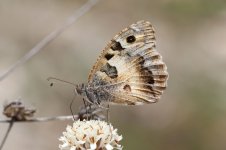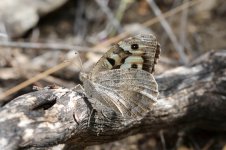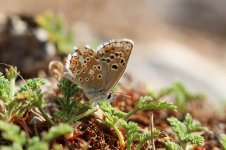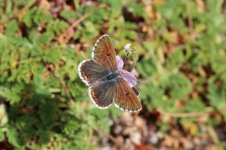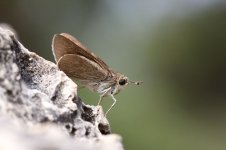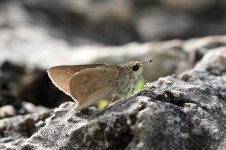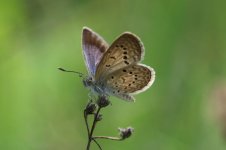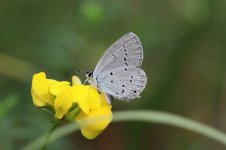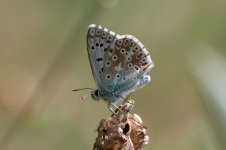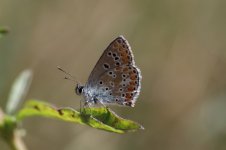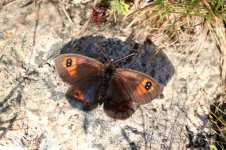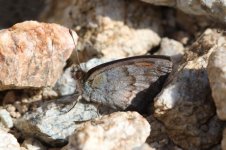-
Welcome to BirdForum, the internet's largest birding community with thousands of members from all over the world. The forums are dedicated to wild birds, birding, binoculars and equipment and all that goes with it.
Please register for an account to take part in the discussions in the forum, post your pictures in the gallery and more.
You are using an out of date browser. It may not display this or other websites correctly.
You should upgrade or use an alternative browser.
You should upgrade or use an alternative browser.
Butterflies of north-east Spain (Montes Universales & Pyrenees). 4-15 August 2021. (1 Viewer)
- Thread starter Jos Stratford
- Start date
More options
Who Replied?

9 August. Noguera.
Second visit to Noguera, this barranco again proving most excellent - increase in Iberian Sooty Coppers, now a total of eight in the damp meadows, plus 15 Cardinal Fritillaries (none on the first visit) and five Chapman’s Blues (absent or overlooked on first visit). Only one new species for the trip, two fresh Green-veined Whites, but plenty to entertain - still the hordes of Azure Chalkhill Blues, umpteen graylings of five different species and added extras such as Mother-of-Pearl Blue, Ilex Hairstreak and one fairly fresh Spanish Gatekeeper (heavily outnumbered by abundant Gatekeepers).
Exceptionally hot on this day, but I decided to once again try to reach the summit at Sierra Alta - now knowing the sign didn’t prohibit access, I drove a little closer to the summit and hiked the last section. On route up, Great Banded Graylings and Rock Graylings abundant in the open pine, plus a few Wall Browns, then at the summit itself, a small open rocky plateau, a mixed bunch of Swallowtails and Iberian Scarce Swallowtails ‘mountain-topping’, the practice of some butterflies to congregate at the peaks of hills. Also here, Silver-spotted Skippers, Clouded Yellows and several Graylings, but as for Mountain Argus, not a single one. Departing however, I immediately found three Aricia sp. in an open area just below the tree line. ‘Well that was good’, thought I, ‘Mountain Argus’. Try as I might however, I could not see any reason why these were not Southern Brown Arguses - well-developed orange markings on the upper wings, no appreciable differences to the fairly common Southern Brown Arguses I had been encountering everyday in the barrancos. Alas, I had to concede that I was not looking at Mountain Argus.
With that, I returned to Torres de Albarracin, still Griffon Vultures stacking the air, Spotless Starlings in the village and Booted Eagle again overhead.
Second visit to Noguera, this barranco again proving most excellent - increase in Iberian Sooty Coppers, now a total of eight in the damp meadows, plus 15 Cardinal Fritillaries (none on the first visit) and five Chapman’s Blues (absent or overlooked on first visit). Only one new species for the trip, two fresh Green-veined Whites, but plenty to entertain - still the hordes of Azure Chalkhill Blues, umpteen graylings of five different species and added extras such as Mother-of-Pearl Blue, Ilex Hairstreak and one fairly fresh Spanish Gatekeeper (heavily outnumbered by abundant Gatekeepers).
Exceptionally hot on this day, but I decided to once again try to reach the summit at Sierra Alta - now knowing the sign didn’t prohibit access, I drove a little closer to the summit and hiked the last section. On route up, Great Banded Graylings and Rock Graylings abundant in the open pine, plus a few Wall Browns, then at the summit itself, a small open rocky plateau, a mixed bunch of Swallowtails and Iberian Scarce Swallowtails ‘mountain-topping’, the practice of some butterflies to congregate at the peaks of hills. Also here, Silver-spotted Skippers, Clouded Yellows and several Graylings, but as for Mountain Argus, not a single one. Departing however, I immediately found three Aricia sp. in an open area just below the tree line. ‘Well that was good’, thought I, ‘Mountain Argus’. Try as I might however, I could not see any reason why these were not Southern Brown Arguses - well-developed orange markings on the upper wings, no appreciable differences to the fairly common Southern Brown Arguses I had been encountering everyday in the barrancos. Alas, I had to concede that I was not looking at Mountain Argus.
With that, I returned to Torres de Albarracin, still Griffon Vultures stacking the air, Spotless Starlings in the village and Booted Eagle again overhead.


10 August. Tragacete (Puerto de la Portillo & Río Júcar)
Although I had planned to spend the entire trip in the Montes Universales, my early success now left me with the possibility to add extensions - time to head for the coast! Before departing however, I decided I would explore the Tragacete area on the eastern edge of the Montes Universales, an area that I had chalked up as a potential back-up site for Zapater's Ringlet had I not already seen them (though I didn't actually have a concrete site for themat this locality).
My first stop of the morning was at Puerto de la Portillo, a rocky ridge sitting at 1790 metres and the only known site for Spanish Argus in the region. I arrived pretty early, the sun just beginning to drench the open rockland, but no butterflies on the wing as yet. On the bird front, Rock Thrushes, Black Redstarts and Black-eared Wheatears flitted across the rocks, flocks of Swifts hurtled overhead. Scrambling up the edge of the escarpment, I first kicked up a Rock Grayling, then a Spanish Chalkhill Blue and then, no less than 10 minutes after arriving, a miniscule butterfly lifted into the air from a sheltered gully - I had found a Spanish Argus! With a near total lack of orange markings on the uppers and a large round forewing cell spot on the underwing, this was a distinctive butterfly. As it warmed, so more and more Spanish Arguses appeared, all preferring the very lip of the slope or gulleys on the steep downward side. Highly active, but pausing to nectar on dwarf flowers or take in the sun on south-facing rocks, these were very nice butterflies indeed, rather easier to separate than their Southern Brown Argus/Mountain Argus brethren! Also saw several Wall Browns and Silver-spotted Skippers here.
After a while, I continued a few kilometres and explored the Río Júcar valley north of Tragacete. This was superb! After passing through a relatively narrow section of valley, I encountered a set of meadows bordering a stream and rich in thistle patches. And what a delight those thistles were - butterflies galore, literally hundreds of butterflies. As in many localities, super abundant Gatekeepers, Great Banded Graylings and Rock Graylings, plus too many Graylings, several Tree Graylings and at least 50 Iberian Marbled Whites. In amongst this soup, an impressive showing of about 40 Cardinal Fritillaries, ten Iberian Scarce Swallowtails and four False Graylings, plus plenty of other butterflies, such as Clouded Yellows, Painted Lady, Small Tortoiseshell, Comma and Dusky Meadow Browns. Short turf and assorted flowers added yet more, Azure Chalkhill Blues and Common Blues heading their family, Long-tailed Blue, Lang’s Short-tailed Blue and Turquoise Blue also seen.
Moving back towards Tragacete, I then took a short walk in the steep-sided gorge of the Río Júcar. This truly proved to be an excellent finale to the Montes Universales - not only a Zapater’s Ringlet in a small fragment of meadow aside the stream and a Spanish Purple Hairstreak on flowers next to the road, but one special bonus in an area of rocky scree. In the space of a hundred metres, two superb male Hermits and two females, the latter far more cryptic below. I was very happy with these, a dramatic species that I had only ever seen once before, in Greece in June 2018. I decided this very much compensated for not seeing Southern Hermit.
And with that, I turned eastbound, a drive of several hours to Valencia on the Mediterranean coast. Early evening when I arrived and a bit of high cloud. No butterflies, loads of Glossy Ibises to the north of the city, a few Night Herons too.
Although I had planned to spend the entire trip in the Montes Universales, my early success now left me with the possibility to add extensions - time to head for the coast! Before departing however, I decided I would explore the Tragacete area on the eastern edge of the Montes Universales, an area that I had chalked up as a potential back-up site for Zapater's Ringlet had I not already seen them (though I didn't actually have a concrete site for themat this locality).
My first stop of the morning was at Puerto de la Portillo, a rocky ridge sitting at 1790 metres and the only known site for Spanish Argus in the region. I arrived pretty early, the sun just beginning to drench the open rockland, but no butterflies on the wing as yet. On the bird front, Rock Thrushes, Black Redstarts and Black-eared Wheatears flitted across the rocks, flocks of Swifts hurtled overhead. Scrambling up the edge of the escarpment, I first kicked up a Rock Grayling, then a Spanish Chalkhill Blue and then, no less than 10 minutes after arriving, a miniscule butterfly lifted into the air from a sheltered gully - I had found a Spanish Argus! With a near total lack of orange markings on the uppers and a large round forewing cell spot on the underwing, this was a distinctive butterfly. As it warmed, so more and more Spanish Arguses appeared, all preferring the very lip of the slope or gulleys on the steep downward side. Highly active, but pausing to nectar on dwarf flowers or take in the sun on south-facing rocks, these were very nice butterflies indeed, rather easier to separate than their Southern Brown Argus/Mountain Argus brethren! Also saw several Wall Browns and Silver-spotted Skippers here.
After a while, I continued a few kilometres and explored the Río Júcar valley north of Tragacete. This was superb! After passing through a relatively narrow section of valley, I encountered a set of meadows bordering a stream and rich in thistle patches. And what a delight those thistles were - butterflies galore, literally hundreds of butterflies. As in many localities, super abundant Gatekeepers, Great Banded Graylings and Rock Graylings, plus too many Graylings, several Tree Graylings and at least 50 Iberian Marbled Whites. In amongst this soup, an impressive showing of about 40 Cardinal Fritillaries, ten Iberian Scarce Swallowtails and four False Graylings, plus plenty of other butterflies, such as Clouded Yellows, Painted Lady, Small Tortoiseshell, Comma and Dusky Meadow Browns. Short turf and assorted flowers added yet more, Azure Chalkhill Blues and Common Blues heading their family, Long-tailed Blue, Lang’s Short-tailed Blue and Turquoise Blue also seen.
Moving back towards Tragacete, I then took a short walk in the steep-sided gorge of the Río Júcar. This truly proved to be an excellent finale to the Montes Universales - not only a Zapater’s Ringlet in a small fragment of meadow aside the stream and a Spanish Purple Hairstreak on flowers next to the road, but one special bonus in an area of rocky scree. In the space of a hundred metres, two superb male Hermits and two females, the latter far more cryptic below. I was very happy with these, a dramatic species that I had only ever seen once before, in Greece in June 2018. I decided this very much compensated for not seeing Southern Hermit.
And with that, I turned eastbound, a drive of several hours to Valencia on the Mediterranean coast. Early evening when I arrived and a bit of high cloud. No butterflies, loads of Glossy Ibises to the north of the city, a few Night Herons too.
Andy Adcock
Worst person on Birdforum

Not sure you labelled this batch right........there's a Hairstreak at the end?A few more from Noguera:
Iberian Scarce Swallowtail
Southern Brown Argus
Cinquefoil Skipper
False Ilex Skipper
View attachment 1403947View attachment 1403948View attachment 1403949View attachment 1403950View attachment 1403951

Since there's no such thing as a False Ilex Skipper, I think you can guess the typo. Now editedNot sure you labelled this batch right........there's a Hairstreak at the end?
Last edited:



11 August. Albufera, Valencia.
Jeepers, hot and sweaty in Valencia, the sun beating down on the wetlands to concoct sauna-like conditions. Despite greenery around water areas, Albufera is pretty much devoid of butterflies in the heat of summer, but in that vacuum there do exist two species that I seeked - hot country specialists, African Grass Blue and Mediterranean Skipper. I didn't have any specific locations for either, but used Google satellite maps to pinpoint localities that looked promising - in a landscape of endless rice paddies, a small raised 'island' at Ermita dels Benissants de la Pedra seemed to offer a bit of rough grassland and some rocky slopes ... perfect to my way of thinking for both species. Failing that, I would simply tour the embankments between the paddies for the Grass Blue and head to the coastal sand dunes for Mediterranean Skipper. Turned out my hunch was not bad - only three species of butterflies at Ermita dels Benissants de la Pedra, but fortunately the most abundant of these was indeed Mediterranean Skipper. Around the rough grass and lower rocky area, at least 15 Mediterranean Skippers were found ...and quite sweat-inducing it was to lie on the ground to photograph them! Alongside, four Mallow Skippers and a couple of Lang's Short-tailed Blues. I added African Grass Blues on an embankment less than a kilometre away - highly active, and in company with Lang's Short-tailed Blues, these tiny little butterflies sapped yet more energy as I pursued them back and fro. Finally got photographs, happy with that.
By the end of the day, though the two targets had both been seen, the day tally reflected the severe lack of butterflies in the general area - a mere eight species recorded (the above, plus Small White, Clouded Yellow, Striped Grayling and Sage Skipper).
Pretty good for birds however - I didn't go out of my way to look for them, but abundant Glossy Ibises in the paddies, along with Night Herons and Squacco Herons, plentiful Little Egrets and quite a few Whiskered Terns and Gull-billed Terns. In drier areas, Woodchat Shrike, Hoopoes and Sardinian Warblers, plus one Orphean Warbler. Also saw Red-rumped Swallow.
Retired relatively early this day, staying overnight on the edge of Valencia.
Jeepers, hot and sweaty in Valencia, the sun beating down on the wetlands to concoct sauna-like conditions. Despite greenery around water areas, Albufera is pretty much devoid of butterflies in the heat of summer, but in that vacuum there do exist two species that I seeked - hot country specialists, African Grass Blue and Mediterranean Skipper. I didn't have any specific locations for either, but used Google satellite maps to pinpoint localities that looked promising - in a landscape of endless rice paddies, a small raised 'island' at Ermita dels Benissants de la Pedra seemed to offer a bit of rough grassland and some rocky slopes ... perfect to my way of thinking for both species. Failing that, I would simply tour the embankments between the paddies for the Grass Blue and head to the coastal sand dunes for Mediterranean Skipper. Turned out my hunch was not bad - only three species of butterflies at Ermita dels Benissants de la Pedra, but fortunately the most abundant of these was indeed Mediterranean Skipper. Around the rough grass and lower rocky area, at least 15 Mediterranean Skippers were found ...and quite sweat-inducing it was to lie on the ground to photograph them! Alongside, four Mallow Skippers and a couple of Lang's Short-tailed Blues. I added African Grass Blues on an embankment less than a kilometre away - highly active, and in company with Lang's Short-tailed Blues, these tiny little butterflies sapped yet more energy as I pursued them back and fro. Finally got photographs, happy with that.
By the end of the day, though the two targets had both been seen, the day tally reflected the severe lack of butterflies in the general area - a mere eight species recorded (the above, plus Small White, Clouded Yellow, Striped Grayling and Sage Skipper).
Pretty good for birds however - I didn't go out of my way to look for them, but abundant Glossy Ibises in the paddies, along with Night Herons and Squacco Herons, plentiful Little Egrets and quite a few Whiskered Terns and Gull-billed Terns. In drier areas, Woodchat Shrike, Hoopoes and Sardinian Warblers, plus one Orphean Warbler. Also saw Red-rumped Swallow.
Retired relatively early this day, staying overnight on the edge of Valencia.


12 August. To the Pyrenees.
35 C and exceptionally humid in Valencia. With the temperature set to soar into the middle 40s in the coming days, I decided it would be a wise move to shift 500 km to the north and venture into the Pyrenees, cooler perhaps and certainly without the humidity. So it was, largely a travel day - temperature hit 41 C as I skirted inland of Barcelona, a brief stop there adding Short-tailed Blue, Dusky Heath and both Spanish and Southern Gatekeepers. Got to the equaly hot foothills just south of Ripoll in the late afternoon and, glutton for punishment, took a detour to some random stops in the wooded valleys near the village of Sora. Despite the heat, amazingly productive, even more so as evening approached - Short-tailed Blue, Provinçal Short-tailed Blue and Lang's Short-tailed Blues all active together, along with Long-tailed Blues, Holly Blues, Common Blues, Turquoise Blue and two Provence Chalkhill Blues. Equally good, Weaver's Fritillary and Knapweed Fritillary, both new for the trip, and a variety of others, including Mallow Skippers, Spanish Gatekeepers and both Swallowtail and Iberian Scarce Swallowtail. Surprise of the day however, just as the sun began to set over the mountain peaks, two very stunning Brown Hairstreaks, always fantastic butterflies.
So there it was, largely a day of travel, but this unexpectedly good stop took the day's butterfly tally to 36 species. Drove a few kilometres more and stopped the night aside the river in the picturesque town of San Jose de les Abadesses.
35 C and exceptionally humid in Valencia. With the temperature set to soar into the middle 40s in the coming days, I decided it would be a wise move to shift 500 km to the north and venture into the Pyrenees, cooler perhaps and certainly without the humidity. So it was, largely a travel day - temperature hit 41 C as I skirted inland of Barcelona, a brief stop there adding Short-tailed Blue, Dusky Heath and both Spanish and Southern Gatekeepers. Got to the equaly hot foothills just south of Ripoll in the late afternoon and, glutton for punishment, took a detour to some random stops in the wooded valleys near the village of Sora. Despite the heat, amazingly productive, even more so as evening approached - Short-tailed Blue, Provinçal Short-tailed Blue and Lang's Short-tailed Blues all active together, along with Long-tailed Blues, Holly Blues, Common Blues, Turquoise Blue and two Provence Chalkhill Blues. Equally good, Weaver's Fritillary and Knapweed Fritillary, both new for the trip, and a variety of others, including Mallow Skippers, Spanish Gatekeepers and both Swallowtail and Iberian Scarce Swallowtail. Surprise of the day however, just as the sun began to set over the mountain peaks, two very stunning Brown Hairstreaks, always fantastic butterflies.
So there it was, largely a day of travel, but this unexpectedly good stop took the day's butterfly tally to 36 species. Drove a few kilometres more and stopped the night aside the river in the picturesque town of San Jose de les Abadesses.


13 August. Vallter 2000.
I hadn't done any research for the Pyrenees prior to my trip, so I selected this locality simply by its location - a ski resort at 2000 metres, offering easy hiking to slopes at 2500 metres right on the French border. Not a bad choice it turned out - in the early morning sunshine, the first butterfly of the day was a Spanish Brassy Ringlet, a new species for me. As it warmed, it turned out that this species was abundant - many hundreds on the grazed Alpine meadows right up to my maximum altitude. Spectacular landscapes, but surprisingly devoid of other butterfly species - just two more: several Silver-spotted Skippers and three Small Tortoiseshells. Huge numbers of Citril Finches however, all rather tame and feeding on dwarf thistles. Alpine Choughs and Alpine Marmots too.
Cracking stuff lower down, first one Mountain Small White and several Large Grizzled Skippers, then at about 1850 metres the butterfly action really started - among many others, I was soon encountering new species for the trip - Scarce Coppers, Sooty Coppers, Ringlets, Large Ringlet, Pearly Heaths, Lulworth Skippers. It was then non-stop top class action all the way down, hundreds of Gatekeepers, fairly common Iberian Marbled Whites, a scattering of Common Blues, one Mountain Argus, one Spanish Chestnut Heath and a bonanza of fritillaries - Queen of Spain, Silver-washed, High Brown, Knapweed, Spotted, Heath and, requiring careful perusal, Provinçal Fritillaries.
Descending yet further, the temperature beginning its relentless climb into the high 30s, abundant Province Chalkhill Blues began to appear, along several Provinçal Short-tailed Blues, one Turquoise Blue, both Lang's Short-tailed Blues and Long-tailed Blues and the only White-letter Hairstreak of the trip. Concluding the day, with an eye out for Purple Hairstreak, I then decided to explore a series of sunny woodland tracks alongside the river near San Jose de les Abadesses. Success - not only one Purple Hairstreak, albeit typically uncooperative for photographs, but also at least eight White Admirals, one Lesser Purple Emperor and about eight Woodland Graylings, all of which were new for the trip. Speckled Wood, Red Admiral, Comma and Painted Lady here too.
And so ended the day, even at this elevation a hot 35 C, but highly productive it had been - 55 species, 15 of which were new for the trip.
I hadn't done any research for the Pyrenees prior to my trip, so I selected this locality simply by its location - a ski resort at 2000 metres, offering easy hiking to slopes at 2500 metres right on the French border. Not a bad choice it turned out - in the early morning sunshine, the first butterfly of the day was a Spanish Brassy Ringlet, a new species for me. As it warmed, it turned out that this species was abundant - many hundreds on the grazed Alpine meadows right up to my maximum altitude. Spectacular landscapes, but surprisingly devoid of other butterfly species - just two more: several Silver-spotted Skippers and three Small Tortoiseshells. Huge numbers of Citril Finches however, all rather tame and feeding on dwarf thistles. Alpine Choughs and Alpine Marmots too.
Cracking stuff lower down, first one Mountain Small White and several Large Grizzled Skippers, then at about 1850 metres the butterfly action really started - among many others, I was soon encountering new species for the trip - Scarce Coppers, Sooty Coppers, Ringlets, Large Ringlet, Pearly Heaths, Lulworth Skippers. It was then non-stop top class action all the way down, hundreds of Gatekeepers, fairly common Iberian Marbled Whites, a scattering of Common Blues, one Mountain Argus, one Spanish Chestnut Heath and a bonanza of fritillaries - Queen of Spain, Silver-washed, High Brown, Knapweed, Spotted, Heath and, requiring careful perusal, Provinçal Fritillaries.
Descending yet further, the temperature beginning its relentless climb into the high 30s, abundant Province Chalkhill Blues began to appear, along several Provinçal Short-tailed Blues, one Turquoise Blue, both Lang's Short-tailed Blues and Long-tailed Blues and the only White-letter Hairstreak of the trip. Concluding the day, with an eye out for Purple Hairstreak, I then decided to explore a series of sunny woodland tracks alongside the river near San Jose de les Abadesses. Success - not only one Purple Hairstreak, albeit typically uncooperative for photographs, but also at least eight White Admirals, one Lesser Purple Emperor and about eight Woodland Graylings, all of which were new for the trip. Speckled Wood, Red Admiral, Comma and Painted Lady here too.
And so ended the day, even at this elevation a hot 35 C, but highly productive it had been - 55 species, 15 of which were new for the trip.


14 August. Nuria (Fontalba).
A similar elevation and only a dozen or so kilometres west of Vallter 2000, but quite notably a different butterfly selection. Arrived as the sun began to hit the slopes, already over 20 C, and immediately ran into new butterflies - in quite some abundance, flying primarily just below the tree line, Piedmont Ringlets drifting back and fro, very nice. One Lesser Purple Emperor too, plus the first Spotted Fritillaries of the day.
A little higher, with two Pyrenean Chamois standing sentinel on a rock top and several Alpine Marmots scampering off, I decided first to explore the open slopes above the tree line - plenty of Spanish Brassy Ringlets again, but actively hill-topping were also another two new species for the trip - at least six Purple-shot Coppers and a few Large Wall Browns. Large Grizzled Skippers, Small Coppers and Wall Browns also hill-topping. A little unexpected, four Chalkhill Blues also here - the 2000 metre elevation effectively ruling out Province Chalkhill and thus adding another new species for the trip. Further up, still plenty of Spanish Brassy Ringlets, but not many additional species, the main attraction here being a recently dead calf - as upward of 25 Griffon Vultures dropped onto the turf, mama cow cast a sorry figure as she repeatedly tried to drive the vultures off. She would not win and a half hour later, mooing in despondency, she headed up the slope to other cows, the Griffons beginning a noisy free for all at the carcass.
Temperature climbing, I decided to spend the rest of the morning slowly descending beneath the tree line through a series of excellent mixed meadows and forest edges. Many butterflies, not least lots of Piedmont Ringlets, one late Apollo, Queen of Spain Fritillaries and Knapweed Fritillaries, three Mountain Arguses and several Rock Graylings. Lower down, Gatekeepers again in abundance, a couple of Scarce Coppers, a Swallowtail and increasing numbers of common lowland species (Silver-washed Fritillaries, Meadow Browns, mixed whites, etc). Below 1000 metres, Province Chalkhill Blues began to appear, a shade paler and greyer than the Chalkhill Blues earlier, plus what I presume were Woodland Graylings (appearing larger than Rock Graylings and inhabiting bushy meadow areas). Also here, Short-tailed Blues, White Admirals, Cleopatra and, puddling aside a stream, a mix of Large Grizzled Skippers and Oberthur's Grizzled Skippers.
By now, early afternoon and stonking hot, it was time to quit the mountains and head back to Barcelona, the trip nearing its end. A warm 40 C on the lowland plains, stops were pretty unproductive, but I did manage one final addition - after dropping off the car at the airport, one very nice Geranium Bronze flitting around in a bit of urban parkland in the nearby town area of El Prat. And so it was, the final species and final butterfly of the trip.
A similar elevation and only a dozen or so kilometres west of Vallter 2000, but quite notably a different butterfly selection. Arrived as the sun began to hit the slopes, already over 20 C, and immediately ran into new butterflies - in quite some abundance, flying primarily just below the tree line, Piedmont Ringlets drifting back and fro, very nice. One Lesser Purple Emperor too, plus the first Spotted Fritillaries of the day.
A little higher, with two Pyrenean Chamois standing sentinel on a rock top and several Alpine Marmots scampering off, I decided first to explore the open slopes above the tree line - plenty of Spanish Brassy Ringlets again, but actively hill-topping were also another two new species for the trip - at least six Purple-shot Coppers and a few Large Wall Browns. Large Grizzled Skippers, Small Coppers and Wall Browns also hill-topping. A little unexpected, four Chalkhill Blues also here - the 2000 metre elevation effectively ruling out Province Chalkhill and thus adding another new species for the trip. Further up, still plenty of Spanish Brassy Ringlets, but not many additional species, the main attraction here being a recently dead calf - as upward of 25 Griffon Vultures dropped onto the turf, mama cow cast a sorry figure as she repeatedly tried to drive the vultures off. She would not win and a half hour later, mooing in despondency, she headed up the slope to other cows, the Griffons beginning a noisy free for all at the carcass.
Temperature climbing, I decided to spend the rest of the morning slowly descending beneath the tree line through a series of excellent mixed meadows and forest edges. Many butterflies, not least lots of Piedmont Ringlets, one late Apollo, Queen of Spain Fritillaries and Knapweed Fritillaries, three Mountain Arguses and several Rock Graylings. Lower down, Gatekeepers again in abundance, a couple of Scarce Coppers, a Swallowtail and increasing numbers of common lowland species (Silver-washed Fritillaries, Meadow Browns, mixed whites, etc). Below 1000 metres, Province Chalkhill Blues began to appear, a shade paler and greyer than the Chalkhill Blues earlier, plus what I presume were Woodland Graylings (appearing larger than Rock Graylings and inhabiting bushy meadow areas). Also here, Short-tailed Blues, White Admirals, Cleopatra and, puddling aside a stream, a mix of Large Grizzled Skippers and Oberthur's Grizzled Skippers.
By now, early afternoon and stonking hot, it was time to quit the mountains and head back to Barcelona, the trip nearing its end. A warm 40 C on the lowland plains, stops were pretty unproductive, but I did manage one final addition - after dropping off the car at the airport, one very nice Geranium Bronze flitting around in a bit of urban parkland in the nearby town area of El Prat. And so it was, the final species and final butterfly of the trip.
foresttwitcher
Virtually unknown member

Good stuff, as always, Jos - enjoyed the read.

Many thanks, a final few photos to post, and maybe a species listGood stuff, as always, Jos - enjoyed the read.

Just to round this off, a trip list of species seen - 112 species in total, including 81 in the Montes Universales, 74 in the Pyrenees, eight on the Mediterranean Coast:
Old World Swallowtail. Montes Universales, Pyrenees.
Iberian Scarce Swallowtail. Montes Universales, Pyrenees.
Apollo. Pyrenees.
Large White. Montes Universales, Pyrenees.
Small White. Montes Universales, Mediterranean Coast. Pyrenees.
Southern Small White. Montes Universales, Pyrenees.
Mountain Small White. Pyrenees.
Green-veined White. Montes Universales, Pyrenees.
Bath White. Montes Universales, Pyrenees.
Clouded Yellow. Montes Universales, Mediterranean Coast. Pyrenees.
Berger's Clouded Yellow. Montes Universales, Pyrenees.
Brimstone. Montes Universales, Pyrenees.
Cleopatra. Montes Universales, Pyrenees.
Wood White. Montes Universales, Pyrenees.
Spanish Purple Hairstreak. Montes Universales,
Purple Hairstreak. Pyrenees.
Sloe Hairstreak. Montes Universales.
Ilex Hairstreak. Montes Universales.
False Ilex Hairstreak. Montes Universales.
White-letter Hairstreak. Pyrenees.
Blue-spot Hairstreak. Montes Universales.
Brown Hairstreak. Pyrenees.
Small Copper. Montes Universales, Pyrenees.
Scarce Copper. Pyrenees.
Sooty Copper. Pyrenees.
Iberian Sooty Copper. Montes Universales.
Purple-shot Copper. Pyrenees.
Geranium Bronze. Mediterranean Coast.
Long-tailed Blue. Montes Universales, Pyrenees.
Lang's Short-tailed Blue. Montes Universales, Mediterranean Coast. Pyrenees.
Short-tailed Blue. Pyrenees.
Provinçal Short-tailed Blue. Pyrenees.
Holly Blue. Montes Universales, Pyrenees.
African Grass Blue. Mediterranean Coast.
Silver-studded Blue. Montes Universales.
Southern Brown Argus. Montes Universales, Pyrenees.
Spanish Argus. Montes Universales.
Mountain Argus. Pyrenees.
Damon Blue. Montes Universales.
Oberthur's Anomalous Blue. Montes Universales.
Turquoise Blue. Montes Universales, Pyrenees.
Mother-of-Pearl Blue. Montes Universales.
Azure Chalkhill Blue. Montes Universales.
Spanish Chalkhill Blue. Montes Universales.
Province Chalkhill Blue. Pyrenees.
Chalkhill Blue. Pyrenees.
Adonis Blue. Montes Universales.
Chapman's Blue. Montes Universales.
Common Blue. Montes Universales, Pyrenees.
Peacock. Montes Universales, Pyrenees.
Lesser Purple Emperor. Pyrenees.
White Admiral. Pyrenees.
Southern White Admiral. Montes Universales.
Red Admiral. Montes Universales, Pyrenees.
Large Tortoiseshell. Montes Universales,
Small Tortoiseshell. Montes Universales, Pyrenees.
Painted Lady. Montes Universales, Pyrenees.
Comma. Montes Universales, Pyrenees.
Cardinal Fritillary. Montes Universales,
Silver-washed Fritillary. Montes Universales, Pyrenees.
Dark Green Fritillary. Montes Universales.
High Brown Fritillary. Montes Universales, Pyrenees.
Queen of Spain Fritillary. Montes Universales, Pyrenees.
Twinspot Fritillary. Montes Universales.
Lesser Marbled Fritillary. Montes Universales.
Spotted Fritillary. Montes Universales, Pyrenees.
Lesser Spotted Fritillary. Montes Universales.
Weaver's Fritillary. Pyrenees.
Knapweed Fritillary. Pyrenees.
Heath Fritillary. Montes Universales, Pyrenees.
Provinçal Fritillary. Pyrenees.
Iberian Marbled White. Montes Universales, Pyrenees.
Esper's Marbled White. Montes Universales.
Woodland Grayling. Pyrenees.
Rock Grayling. Montes Universales, Pyrenees.
Grayling. Montes Universales, Pyrenees.
Tree Grayling. Montes Universales.
Striped Grayling. Montes Universales, Mediterranean Coast.
False Grayling. Montes Universales.
Black Satyr. Montes Universales.
Great Branded Grayling. Montes Universales.
Hermit. Montes Universales.
Large Ringlet. Pyrenees.
Zapater's Ringlet. Montes Universales.
Piedmont Ringlet. Pyrenees.
Spanish Brassy Ringlet. Pyrenees.
Ringlet. Pyrenees.
Meadow Brown. Montes Universales, Pyrenees.
Dusky Meadow Brown. Montes Universales, Pyrenees.
Oriental Meadow Brown. Montes Universales.
Gatekeeper. Montes Universales, Pyrenees.
Southern Gatekeeper. Montes Universales, Pyrenees.
Spanish Gatekeeper. Montes Universales, Pyrenees.
Small Heath. Montes Universales, Pyrenees.
Spanish Chestnut Heath. Montes Universales, Pyrenees.
Pearly Heath. Pyrenees.
Dusky Heath. Montes Universales, Pyrenees.
Speckled Wood. Montes Universales, Pyrenees.
Wall Brown. Montes Universales, Pyrenees.
Large Wall Brown. Pyrenees.
Grizzled Skipper. Montes Universales.
Large Grizzled Skipper. Pyrenees.
Oberthur's Grizzled Skipper. Montes Universales, Pyrenees.
Cinquefoil Skipper. Montes Universales.
Sage Skipper. Montes Universales, Mediterranean Coast.
Mallow Skipper. Mediterranean Coast, Pyrenees.
Mediterranean Skipper. Mediterranean Coast.
Essex Skipper. Montes Universales.
Small Skipper. Montes Universales, Pyrenees.
Lulworth Skipper. Pyrenees.
Silver-spotted Skipper. Montes Universales, Pyrenees.
Large Skipper. Montes Universales, Pyrenees.
Old World Swallowtail. Montes Universales, Pyrenees.
Iberian Scarce Swallowtail. Montes Universales, Pyrenees.
Apollo. Pyrenees.
Large White. Montes Universales, Pyrenees.
Small White. Montes Universales, Mediterranean Coast. Pyrenees.
Southern Small White. Montes Universales, Pyrenees.
Mountain Small White. Pyrenees.
Green-veined White. Montes Universales, Pyrenees.
Bath White. Montes Universales, Pyrenees.
Clouded Yellow. Montes Universales, Mediterranean Coast. Pyrenees.
Berger's Clouded Yellow. Montes Universales, Pyrenees.
Brimstone. Montes Universales, Pyrenees.
Cleopatra. Montes Universales, Pyrenees.
Wood White. Montes Universales, Pyrenees.
Spanish Purple Hairstreak. Montes Universales,
Purple Hairstreak. Pyrenees.
Sloe Hairstreak. Montes Universales.
Ilex Hairstreak. Montes Universales.
False Ilex Hairstreak. Montes Universales.
White-letter Hairstreak. Pyrenees.
Blue-spot Hairstreak. Montes Universales.
Brown Hairstreak. Pyrenees.
Small Copper. Montes Universales, Pyrenees.
Scarce Copper. Pyrenees.
Sooty Copper. Pyrenees.
Iberian Sooty Copper. Montes Universales.
Purple-shot Copper. Pyrenees.
Geranium Bronze. Mediterranean Coast.
Long-tailed Blue. Montes Universales, Pyrenees.
Lang's Short-tailed Blue. Montes Universales, Mediterranean Coast. Pyrenees.
Short-tailed Blue. Pyrenees.
Provinçal Short-tailed Blue. Pyrenees.
Holly Blue. Montes Universales, Pyrenees.
African Grass Blue. Mediterranean Coast.
Silver-studded Blue. Montes Universales.
Southern Brown Argus. Montes Universales, Pyrenees.
Spanish Argus. Montes Universales.
Mountain Argus. Pyrenees.
Damon Blue. Montes Universales.
Oberthur's Anomalous Blue. Montes Universales.
Turquoise Blue. Montes Universales, Pyrenees.
Mother-of-Pearl Blue. Montes Universales.
Azure Chalkhill Blue. Montes Universales.
Spanish Chalkhill Blue. Montes Universales.
Province Chalkhill Blue. Pyrenees.
Chalkhill Blue. Pyrenees.
Adonis Blue. Montes Universales.
Chapman's Blue. Montes Universales.
Common Blue. Montes Universales, Pyrenees.
Peacock. Montes Universales, Pyrenees.
Lesser Purple Emperor. Pyrenees.
White Admiral. Pyrenees.
Southern White Admiral. Montes Universales.
Red Admiral. Montes Universales, Pyrenees.
Large Tortoiseshell. Montes Universales,
Small Tortoiseshell. Montes Universales, Pyrenees.
Painted Lady. Montes Universales, Pyrenees.
Comma. Montes Universales, Pyrenees.
Cardinal Fritillary. Montes Universales,
Silver-washed Fritillary. Montes Universales, Pyrenees.
Dark Green Fritillary. Montes Universales.
High Brown Fritillary. Montes Universales, Pyrenees.
Queen of Spain Fritillary. Montes Universales, Pyrenees.
Twinspot Fritillary. Montes Universales.
Lesser Marbled Fritillary. Montes Universales.
Spotted Fritillary. Montes Universales, Pyrenees.
Lesser Spotted Fritillary. Montes Universales.
Weaver's Fritillary. Pyrenees.
Knapweed Fritillary. Pyrenees.
Heath Fritillary. Montes Universales, Pyrenees.
Provinçal Fritillary. Pyrenees.
Iberian Marbled White. Montes Universales, Pyrenees.
Esper's Marbled White. Montes Universales.
Woodland Grayling. Pyrenees.
Rock Grayling. Montes Universales, Pyrenees.
Grayling. Montes Universales, Pyrenees.
Tree Grayling. Montes Universales.
Striped Grayling. Montes Universales, Mediterranean Coast.
False Grayling. Montes Universales.
Black Satyr. Montes Universales.
Great Branded Grayling. Montes Universales.
Hermit. Montes Universales.
Large Ringlet. Pyrenees.
Zapater's Ringlet. Montes Universales.
Piedmont Ringlet. Pyrenees.
Spanish Brassy Ringlet. Pyrenees.
Ringlet. Pyrenees.
Meadow Brown. Montes Universales, Pyrenees.
Dusky Meadow Brown. Montes Universales, Pyrenees.
Oriental Meadow Brown. Montes Universales.
Gatekeeper. Montes Universales, Pyrenees.
Southern Gatekeeper. Montes Universales, Pyrenees.
Spanish Gatekeeper. Montes Universales, Pyrenees.
Small Heath. Montes Universales, Pyrenees.
Spanish Chestnut Heath. Montes Universales, Pyrenees.
Pearly Heath. Pyrenees.
Dusky Heath. Montes Universales, Pyrenees.
Speckled Wood. Montes Universales, Pyrenees.
Wall Brown. Montes Universales, Pyrenees.
Large Wall Brown. Pyrenees.
Grizzled Skipper. Montes Universales.
Large Grizzled Skipper. Pyrenees.
Oberthur's Grizzled Skipper. Montes Universales, Pyrenees.
Cinquefoil Skipper. Montes Universales.
Sage Skipper. Montes Universales, Mediterranean Coast.
Mallow Skipper. Mediterranean Coast, Pyrenees.
Mediterranean Skipper. Mediterranean Coast.
Essex Skipper. Montes Universales.
Small Skipper. Montes Universales, Pyrenees.
Lulworth Skipper. Pyrenees.
Silver-spotted Skipper. Montes Universales, Pyrenees.
Large Skipper. Montes Universales, Pyrenees.
Users who are viewing this thread
Total: 2 (members: 0, guests: 2)





